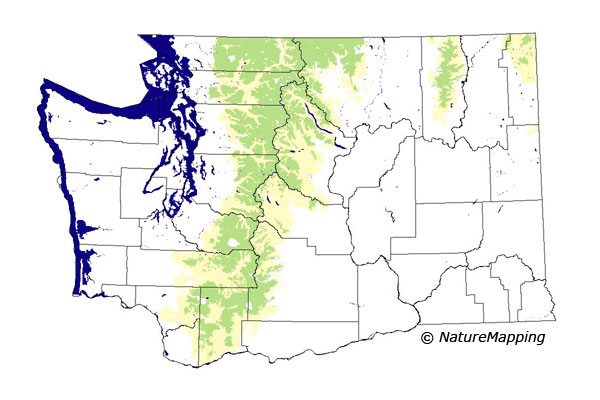
NatureMapping Animal Facts
American Pika
|
American Pika (Ochotona princeps)
Pikas have rounded ears, light brown and gray fur, long whiskers and no visible tails. The body is egg-shaped and the underside is a buffy color.
Body length: 162 to 216 mm (6 to 8.5 in). Average Mass 100 g (3.5 oz).
Range / Habitat: Pikas are found in the rocky terrain in the mountain regions from central British Columbia to South-Central California and east to Colorado. They are often found at the interface between meadow habitat and open rocky terrain. In Washington, the Pika is found living around talus slopes, rock piles, or boulder slides. Found in the Cascades and northeast regions of Washington. Click the range map to learn more about the distribution of Pika in Washington. Diet: The Pika is herbivore that stays active year round even in winter. It survives the cold winter by eating dried vegetation they have stored away in haypiles. They feed on alpine grasses, sedges, thistles, fireweed, cushion plants and lichens. The Pika's food passes quickly though the digestive system and is only partially digested. They often eat their own feces (waste) to extract more nutrients in the digestion process. Behavior: Pikas live in colonies divided into individual territories that they actively defend. The Pika will bark if they are scared and to warn other animals of danger that is near. They can be quiet when a weasel is nearby to avoid being detected. They spend part of their time looking out for predators, defending the territory and protecting their stored food. The short call is given as an alarm call to alert other pikas of avain predators and as a territory defense call. Pikas spend part of the day feeding and haying. Pikas utilize two distinct foraging styles: open foraging (feeding) and food collection and caching (haying). During the summer, they cache vegetation in haypiles composed of tall grasses and forbes. The haypiles are cached (stored) on open surfaces or under rocks within their territory. These haypiles are used to supplement their diet during the harsh winter months. Watch the video. Reproduction: The Pikas mating season is from April to July. They may breed twice a year depending on their location. The gestation period is thirty days long (one month). Pika's will give birth to a litter of 2-5 young. The young are completely dependent on their mother for at least 18 days. The have a fast growth rate and reach adult size when they are only 3 months old. The female weans the young at 3 to 4 weeks after birth.
Did you know?

American Pika More information:
|

